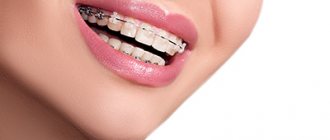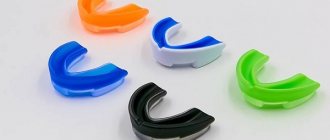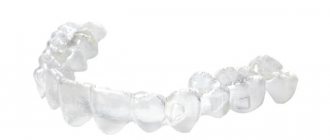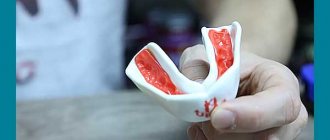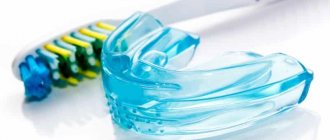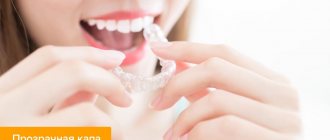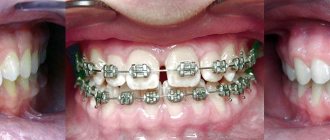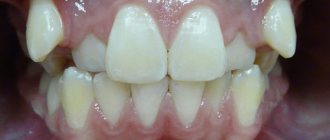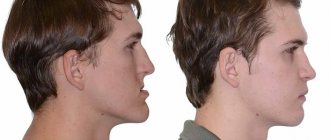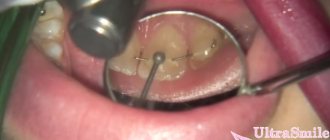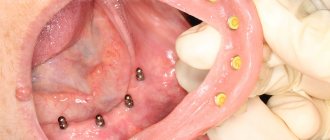Sports mouth guards
A sports lifestyle is becoming more and more popular, and at the same time the number of maxillofacial injuries received during sports is increasing. First of all, the front teeth of the upper jaw are injured; malocclusion in an athlete increases the risk of damage to the dentition.
The most traumatic sports for teeth are hockey, American football, rugby, skating, boxing, kickboxing, but damage to the dentition can occur during any sports activities where contact with a hard surface or other athletes is possible. Professional athletes are required to wear mouthguards; it is recommended that amateur athletes also use this simple but effective means of protection.
Purpose of sports mouthguards, types
What does a mouthguard give an athlete:
- Eliminates the possibility of teeth biting soft tissues at the moment of impact;
- Absorbs and distributes impact energy, thereby reducing the risk of damage to teeth, jaw bones and cervical vertebrae;
- Prevents occlusal contact and injury to opposing teeth during impact;
- Reduces the risk of concussion and the development of neurological disorders;
- Gives the athlete a feeling of confidence in his safety, so during competitions he focuses only on the game;
- Specially made mouthguards increase the strength, endurance and reaction speed of athletes.
Mouth guards can be one-sided (put on one jaw) or two-sided. Also, protective devices are divided into the following groups:
- Standard – sold in sports stores ready-made in several sizes. The disadvantage of such mouthguards is poor fixation on the teeth, lack of individual adjustment to the dentition, low degree of protection;
- Thermoplastic – also sold ready-made, but differ from standard mouthguards in the ability to be adjusted. The material of manufacture is thermoplastic; to adapt to the dentition, the mouth guard is preheated in hot water. They are more comfortable to wear compared to standard ones, but also a little more expensive;
- Individual - made for each athlete according to personal models based on dental casts. It is possible to manufacture mouthguards for teeth with braces, which is important for young athletes, since it is during adolescence that braces are most often installed.
Why do you need a sports mouth guard?
The goal of sports dentistry is to prevent injuries in sports. According to statistics, a high percentage of injuries in various sports are observed in the maxillofacial area: damage to the soft tissues of the oral cavity, teeth, lips, etc. Many of these injuries can be prevented or their consequences reduced if a person uses special protective equipment.
Some athletes require orthodontic treatment with braces. In this case, dental onlays, created according to the individual parameters of a teenager or an adult, take into account the movement of teeth and protect the braces system, as well as the patient himself, from possible damage.
On a note!
Additionally, sports mouthguards, for example, boxing mouth guards for braces, help prevent plates from peeling off from the surface of the teeth and protect soft tissues from injury by individual elements of the system.
General presentation and purpose
The starting point for the use of such structures is the last decade of the century before last, but mass distribution began only towards the middle of the twentieth century. Formally, the inventor of mouthguards in the form in which we know them today is considered to be the American dentist Rodney Liliquist - he was the first to describe in detail the technology for making a protective lining from acrylic.
A sports mouthguard for boxing is a product made of elastic material, worn over the upper dentition, the main function of which is to prevent injuries. Rubber, silicone, acrylic or vinyl acetate polymers are used as the basis for creation. The design separates soft tissues and teeth, absorbing impact energy during physical contact.
Types of mouth guards
There are several types of sports mouthguards.
Single-sided mouth guards
The single-sided or single-jaw pad is comfortable and loved by many athletes. It absorbs up to 40% of the impact force, does not block the flow of air into the lungs and is inexpensive.
Double-sided mouth guards
A double-sided product, made simultaneously for two jaws, protects better than a one-sided one, but makes breathing difficult. It has a small hole for air flow, as a result of which athletes experience a lack of oxygen during a long fight, which affects the intensity of blows, coordination of movements and the general well-being of a person.
Molded mouth guards
The cost of a cast mouth guard is its only advantage. This product is universal and does not fit the shape of the jaw line and protects teeth and gums to a lesser extent. The product can prevent damage to teeth and lips, but does not reduce the force of impact.
On a note!
Another disadvantage of a cast mouthguard is the unpleasant odor.
Thermoplastic mouth guards
An affordable plastic cover that often breaks and does not guarantee the required protection. The product is softened in boiling water, after which the athlete places it on the teeth. In the front part, the material of the mouthguard quickly thins out, providing the least protection to the areas of the oral cavity where maximum protection is required.
Custom mouth guards
Leaders among protective caps. They have a high cost, but compared to previous models they have undeniable advantages:
- ideal anatomical fit to the surface of teeth and braces;
- effective protection;
- no problems with speech and breathing;
- reducing the risk of serious injury;
- decreased intracranial pressure, which increases when struck;
- the ability to drink water and drinks while wearing a mouth guard;
- individualization of the product by putting the athlete’s name or initials on it;
- hypoallergenic and safe material.
Important!
Experts say that athletes who use custom mouthguards are 3 times less likely to experience injuries to the teeth, jaws, and concussions compared to other similar protective equipment.
Choice and features of care
A competent approach to choosing protection is based on several factors:
- Level of load and risk – for light training and sparring at the entry level, the simplest rubber is quite suitable;
- Purchasing budget - if possibilities allow, it is best to order an individual model, which is likely to prevent damage of moderate and severe severity;
- Age of the athlete - a children's mouthguard for boxing should not only protect the child from the consequences of impacts, but also take into account the development of bone tissue, excluding forced deformation of the bite.
Caring for the product is not particularly difficult. Rinse after each use, regularly treat with an antiseptic and store in an airtight case - and it will serve you for 1-1.5 years from the date of purchase.
Sizes and taste qualities of caps
When wearing braces, sports mouthguards should be made from patient impressions from hypoallergenic material using multilayer technology (alternating different layers of hardness).
- Single-layer - product thickness up to 4 mm, recommended for children and non-professional athletes.
- Double-layer ones include two protective layers of 3 mm each. A lightweight option for those involved in professional sports and children.
- Three-layer systems between layers of 2 and 4 mm have an additional reinforced layer of 0.8 mm, protecting the most vulnerable areas of the teeth and soft tissues of the oral cavity. Recommended for use by professional athletes.
Important!
Lack of taste and odor is one of the main requirements for high-quality mouth guards. These criteria must be met at 0%, since when worn they can irritate a person's perception and cause allergies.
Professional sports and braces: compatibility of the incompatible
Statistics show that teeth, and therefore the braces on them, can be injured not only by doing boxing and martial arts or playing hockey, rugby, handball and American football. The list of potentially dangerous sports included skating, basketball, athletics and even tennis. But this did not stop world sports stars from correcting their dentition with orthodontic systems.
Tennis players Anna Kournikova, sisters Williams and Martina Hingis, and basketball stars David Robinson, Sam Bowie and Devon White have had their teeth fixed with braces. Even the famous Carl Lewis, an American track and field athlete who once received the title of the fastest man in the Universe, appeared in the photo wearing braces. When developing a treatment plan for them, orthodontists took into account the fairly high risk of injury to the face and jaws and selected the appropriate design option.
How to choose the right and popular brands
Features of mouth guards from different manufacturers.
- Everlast is the market leader in thermoplastic linings that provide superior oral protection. The brand's products are recommended for both beginners and experienced athletes. Mouthguards are made of plastic, EVA and EverGel technology. Country of origin: China.
- Venum - this brand's onlays are made of Nextfit Gel Frame material, have a low rise and fit the teeth perfectly. The flexibility and comfort of the two-layer system is successfully combined with the absorption of impact forces. Country of origin: Taiwan.
- Opro Gold Level UFC - the manufacturer's mouthguards are suitable for people who wear braces and dental plates. The pads are made of three-layer polymer material, are easy to install in the mouth, and are tasteless and odorless. Country of origin: Great Britain.
- Paffen-Sport presents single-layer mouth guards on the market, recommended for children and adults involved in non-professional sports. They are made of plastic and have a mint flavor. Country of origin: Pakistan.
- Flamma - mouth guards from this manufacturer have a double-sided shape, that is, they protect both jaws at the same time. They are made of high-strength rubber using two-layer technology. Country of origin: China.
An alternative option is the innovative Invisalign system.
Is it possible to do martial arts with braces?
In this case, Invisalign aligners may be a more suitable option. A mouth guard can be offered to athletes with less pronounced bite defects. It is made from a transparent elastic composite using a scanned image of the jaws and bite using IT technologies. The one-piece cast design allows for quick and effective tooth alignment and is an ideal choice for athletic patients.
How to properly use and care for a mouthguard
Using and caring for a mouthguard is not difficult, the main recommendations are:
- Do not expose the product to high temperatures (with the exception of thermoplastic devices). Scalding for the purpose of disinfection and drying in contact with hot surfaces are prohibited. Also, do not consume hot drinks or food while wearing the product.
- It is important to clean your mouthguard morning and evening with toothpaste and a brush intended for daily oral hygiene. If you ignore cleaning, an unpleasant odor and taste will appear as a result of the proliferation of microbes.
- It is recommended to store the pads in cases designed for this purpose.
Alignment tray manufacturing process
The decision on the advisability of wearing mouth guards to straighten the bite is always made by the doctor, after examining the patient and performing a number of diagnostic measures. The specialist will determine the complexity of the defect, take into account the structural features of the patient’s jaws, and if no contraindications to the use of mouthguards are identified, an impression will be taken from the patient’s teeth.
The taken impression is sent to the laboratory, where it is used to model the future design. Based on the model, sets of mouth guards will be produced, which the patient will change during treatment. When the mouth guards are ready, the patient comes to the clinic again, where the design is tried on and the specialist gives detailed advice on how to properly wear and care for the mouth guards.
How long to wear mouthguards after braces?
Recommendations on how long to wear mouth guards after braces can only be provided by your attending physician. Typically, the orthodontist develops a plan for how long mouth guards need to be worn after braces, which helps maintain the correct bite and minimizes possible discomfort for the patient. The doctor will indicate the approximate duration of the retention period.
Immediately after the braces are removed, the patient is usually advised to wear the aligners for a fairly long period of time every day. Most likely, you will have to wear them at night. Gradually, the time of wearing the aligners decreases: after a year, removable structures will need to be worn only once or twice a week. Typically, the timing of the entire “fixing” period is influenced by factors such as:
- type of malocclusion;
- position of teeth before treatment;
- presence of smoking addiction;
- number of teeth removed (according to indications).
Also, the retention period increases if the patient is over 30 years old. Age has a strong influence on the success of malocclusion treatment and on how long you need to wear a mouthguard after removing braces.
Indications for installing trays on teeth
Mouth guards are effective in treating the following situations requiring orthodontic treatment:
· presence of wide interdental spaces;
crowded teeth;
· crossbite;
· excessively wide or narrow dental arch.
In addition, orthodontic aligners prevent the teeth from shifting into the vacant space that appears as a result of the loss of one or more units. They can also straighten a tooth if it has shifted relative to its axis.
Varieties
Research in this area, dictated by demand from professional athletes and boxing fans, has led to the emergence of several variations of protective mouthguards. Almost identical at first glance, they differ in manufacturing technologies, each of which focuses on certain aspects - the degree of protection and shock absorption, the thickness of the product, the method of fixation, coverage area, etc.
Modern mouth guards for boxing are usually divided into single- and double-sided. This criterion determines how the protective plate is fixed - only on the top row, or along the occlusal perimeter. The choice of model depends on the personal preferences of the boxer - some prefer more massive designs that provide reliable protection, while for others freedom of breathing and cervical balance necessary for maneuvering in the ring are important.
From the point of view of the techniques used in manufacturing, there are three categories:
- Universal mouth guards, created in serial lines with different sizes. This is a low-cost option, characterized by a number of disadvantages that appear during operation, such as a short service life, as well as problems with breathing control over a long distance;
- Thermoplastic mouth guards are an adaptive blank that allows you to recreate the structure of the dentition, but at the same time is characterized by the fragility of the finished form;
- Custom mouthguards are a professional option used by athletes and involve the use of special equipment at all stages of manufacturing.
If you are planning to buy a mouthguard for boxing, it is best to focus on quality and reliability. Even in amateur sparring, serious injuries occur, the treatment of the consequences of which is much more expensive than the purchase of good protection. An individual model guarantees the proper level of shock absorption and minimizes the likelihood of serious damage.
Is it possible to practice boxing with braces?
With boxing the situation is more complicated. It's no secret that boxers traditionally enter the ring wearing special protective mouthguards. Therefore, theoretically, the medical Olympic reference book allows for the possibility of an athlete participating in competitions wearing braces. It is emphasized that the treating orthodontist must give his consent to this, and the jaws must be protected by a professionally made individual mouthguard that exactly matches the braces installed on the teeth.
In practice, each boxer must find the answer to this question himself, deciding what is more important for him at this stage - aesthetics or athletic achievements.
How to purchase a mouth guard for dental protection or treatment
Standard sports mouthguards can be purchased at almost any sports store. If you are trying to find a quality product, then you should read reviews on various forums or contact a dentist to have custom mouth guards made. This is what all professional athletes do.
Mouthguards for teeth whitening and treatment of certain diseases can be purchased at the pharmacy. But before starting use, it is still better to consult an appropriate doctor to evaluate all possible treatment options and choose a safer and more effective one.
It is better to order mouth guards for teeth straightening individually from well-known and trusted manufacturers, so as not to waste money and not cause more harm to your health.
Material
Mouthguards are made from special materials that meet their functionality and safety requirements. They are most often made from silicone, POE thermoplastic, or latex. These materials are safe for health and are widely used in various martial arts.
All materials used for dental onlays are divided into cast (non-thermoplastic) and thermoplastic. Thermoplastic protectors - dental protectors - are classified into a separate group.
Cast
These mouthguards are completely ready for use. All you have to do is take them out of the box and put them on your jaw. This is a convenient but not practical option.
It is extremely difficult to choose a ready-made molded mouth guard that would exactly fit a specific jaw. If the guard does not fit tightly on the teeth, it will not provide adequate protection during combat.
Thermoplastic
Thermoplastic mouth guards are semi-finished products from which a mouth guard is yet to be made. The purchased product is heated and placed on the teeth. As the plate cools, it takes on the exact contours of the jaw. Thanks to anatomical precision, thermoplastic pads reliably protect the athlete.
Dental
They are made from individual impressions taken from the athlete’s lower and upper jaw. How to make a dental mouth guard:
- Contact a sports dentist.
- Make a plaster cast of him.
- Receive a custom mouth guard, pressed using special equipment.
The disadvantage of such a mouth guard is its high cost. Such services and products are not cheap. But you can order a product with an individual design - choose any color, make a drawing or inscription. In this way, pros often emphasize their style and extravagance.
Why do you need a mouthguard after braces?
After removing the braces, the patient faces a retention period, which consists of wearing retainers after braces or mouthguards. These are fixed and removable structures, respectively. Retainers are a metal bracket that holds teeth in the desired position. They are installed by a doctor and are not removed during treatment. Mouthguards are removable structures that the patient wears for a certain number of hours a day. They should not be confused with a mouthguard for correcting bites, which is used independently and is an alternative to the braces system. There are also sports mouth guards for braces that protect teeth during traumatic physical activity, but they differ significantly from retention mouth guards.
Mouthguards after braces are removed are necessary to consolidate the success achieved. Many patients, after many months of wearing braces, do not want to put on another orthodontic device, do not understand why a mouth guard is needed after braces, and stop treatment. In this case, the achieved result will be lost. Refusal to wear dental trays after braces will most likely cause the teeth to return to the wrong position, and all the positive effects will be lost. Then the long period of treatment, the money spent and the time spent on straightening the teeth will be in vain. Every patient should understand why they need to wear a mouth guard after braces.
An orthodontic mouthguard after braces will not cause excessive discomfort. This fairly lightweight and discreet device ensures that teeth are held in their new position. An additional function of mouthguards is protection - they protect teeth from mechanical stress.
Mouth guards after braces - price
Prices for mouth guards after braces are removed, as well as for other orthodontic services, largely depend on the level of dentistry in Moscow, quality and type. When paying for treatment with a braces system as a set, turnkey, mouthguards are included in the price. This should be discussed in advance during your visit to the orthodontist. If the patient paid for all procedures separately, then the price for mouth guards will be from 5,000 rubles. This is not the most expensive part of treatment with braces.
Retention trays are very convenient for consolidating the success of orthodontic treatment. If the patient fulfills all the doctor’s requirements and wears the device for the required amount of time, the result achieved in the process of correcting the bite will remain forever. Be sure to wear mouthguards after braces - and straight teeth will be a source of pride.
Features of wearing mouth guards after braces
After removing braces, mouth guards can be made individually for the patient, but this is not necessary. In some cases, standard models are also used. Typically, mouthguards are made from biopolymers that are absolutely hypoallergenic. They do not injure the mucous membranes of the oral cavity and practically do not cause discomfort and do not interfere with eating. The patient does not have to worry about how to put on mouth guards after braces - this does not require special skills; anyone can handle this operation on their own. Questions about how to wear a mouthguard after braces usually do not arise.
However, wearing a mouthguard after braces is still a full-fledged period of treatment, and it has its drawbacks. Among them:
- provoking active salivation - hypersalivation;
- some problems with the pronunciation of certain sounds;
- frequent visits to the orthodontist.
Despite these small problems, the question is: “Do I need to wear aligners after braces?” – should not arise. The answer to this is clear - a mouth guard must be used after braces for the above reasons.
